
Wednesday January 25, 2006
Hometown Heroes!
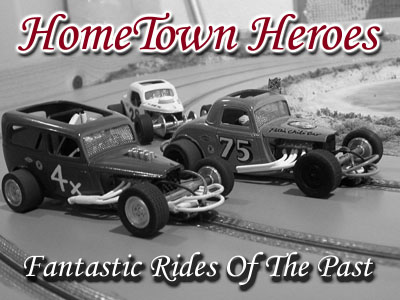 A hot
summer night at Gage County fairgrounds in the early ‘60s – bugs buzzing around
the lights, popcorn and Nehi grape soda in hand, tinny PA system being drowned
out by the staccato brappity-brap of the pits -- this is the type of racing I
grew up with – modified stock cars and jalopies running on a dirt oval.
A hot
summer night at Gage County fairgrounds in the early ‘60s – bugs buzzing around
the lights, popcorn and Nehi grape soda in hand, tinny PA system being drowned
out by the staccato brappity-brap of the pits -- this is the type of racing I
grew up with – modified stock cars and jalopies running on a dirt oval.
As kids we built up soap box derby-type carts with paint and numbers like our heroes. I’m now trying to recreate 1/32 slot versions of the cars and drivers of my youth (although admittedly limited by my aging memory) by using old Pyro, Lindberg, Aurora and Palmer bodies I’ve scrounged up.
#4X
The #4x sedan is my attempt at modeling Lloyd Beckman’s car. Beckman drove sprints and modifieds back in the 60s and 70s for Bill Smith’s Speedway Motors out of Lincoln, Nebraska (still going strong and billed as “America’s Oldest Speedshop”). He was top dog in the area and was considered the “bad guy” by me and my friends (the “x” in his number added a sinister touch), who were always rooting for our local heroes to beat him. Didn’t do much good as Beckman eventually was elected to the sprint car hall of fame.
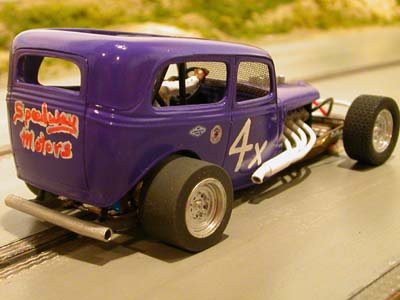
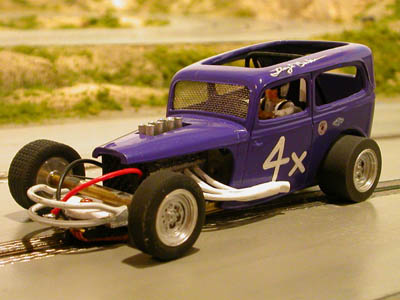
The car started out as a Hot Wheels ’34 delivery van. I cut 1/4 inch from its length to make it about the same as a normal sedan, and cut out the side window and roof panels. It has a scratched pan chassis with Sakatsu motor (about the same as a Plafit Rabbit), with BWA wheels and inserts and Slot-It gears. Indy Grips on the rear. The fat right front tire is a knobby borrowed from a Scaley GT40. In real life these cars were set up that way to facilitate turning left, but I haven’t noticed any ill effects on my road course. I also employed a Prof. Fate floating front end which seems to work nicely and makes guide set-up a lot easier.
The hardest part of building the car was deciding how much detail to include. Since these cars were literally “bare bones,” nearly everything is exposed. I’ve seen exquisite examples of full tube chassis by masters such as Al Penrose and Tom Miner, but I’m not in their league. I decided to add a simple roll cage of brass rod, and managed to include a full Fly driver. (Really the driver should be wearing a T shirt with a pack of cigarettes rolled up in the sleeve.) The engine block was resin cast from a cheap die cast toy, and injector stacks were scratched from aluminum tubing. Exhaust headers were a lot of work. I couldn’t find anything appropriate in plastic, and tubing tended to kink, so I wound up using individual brass rods soldered into a larger piece of tubing. This adds a lot of weight to the front end and I have subsequently used other techniques for later projects. The car is no lightweight given all the brass used in its construction, but is very smooth and quick enough.
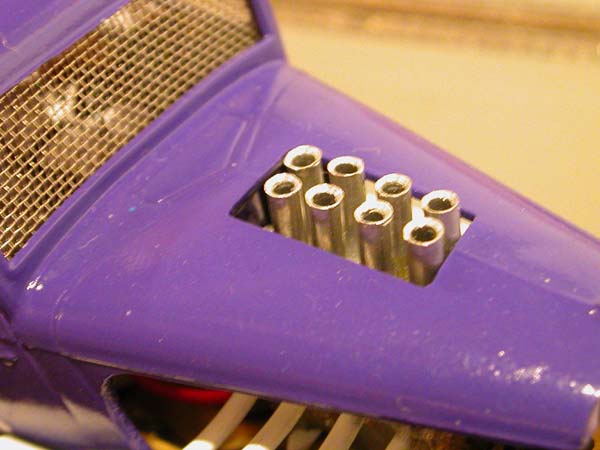
These cars were often hand-painted (sometimes using house paint with a broom it seemed) so I painted the numbers and sponsor by hand. I can’t swear it is an accurate model as I don’t have any pictures or documentation on the real car, which no doubt changed from week to week anyway, and am relying on my memory for details. The car is sprayed with Tamiya purple over gray primer, and is a bit darker than I intended. I probably should have used white primer.
#28
The ’36 Ford coupe uses a Palmer body and is meant to depict a car driven by Frankie Brennfoerder, one of the better known and liked drivers of the era. The “battle damage” on the right side of the body was a molding defect from the manufacturer. I considered repairing it, but then decided it added a touch of realism. These cars were constantly banging into each other and were never pristine.
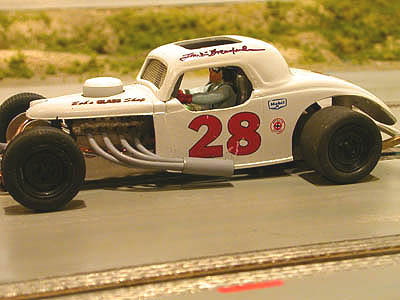
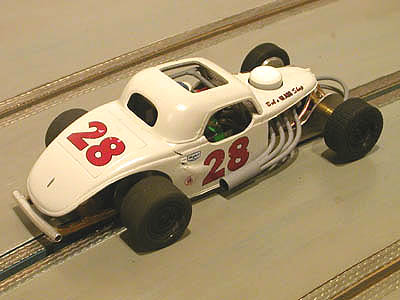
Chassis is a modified stainless steel offering from Slot Car Heroes. I originally intended to use it stock, but needed to add clearance so notched out the overlapping parts of the pan to allow them to fit flush with each other. Motor is one of the green end bell specials, which provides decent performance on a short track, although I may eventually upgrade it. Wheels are the plastic TSRF units that came with the chassis, but I have added vintage stocker inserts from BWA. I used wide tires on all the cars since that is what I remember, but in reality they probably should have narrower units. Call it poetic license. Other details – bumpers, mill, roll cage, etc. are similar to the ’34 sedan. Headers are wire-filled styrene cemented to the larger outlet tube. Air cleaner is a turned down wheel from a snap-tite kit. Decals by Patto.
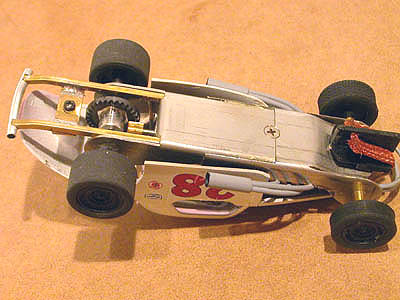
What I find particularly fun with these cars are the body modifications. There are no “official” prototype drawings, and although lots of cars started with the same stock body, each car was uniquely modified – chopped, channeled, drilled full of holes, etc. It is liberating to grind away with a Dremel without worrying about messing it up. Unless you go WAY overboard, they all look the part.
#75
The third car is a Pyro ’34 Ford coupe, and is meant to depict (again, from memory) the car Roy “The Rebel” McCain drove in the mid-60s. Roy was one of the top drivers in the area and a real crowd favorite. Although he lived and competed in the Midwest, he was originally from Alabama, and always ran with a confederate flag flapping on his car. At that time the flag was considered a colorful expression of southern heritage rather than a divisive political issue or symbol of racial oppression. (This was long before the Dukes of Hazzard TV series.)
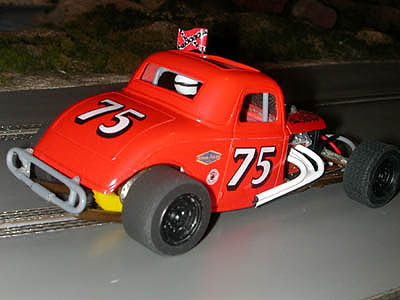
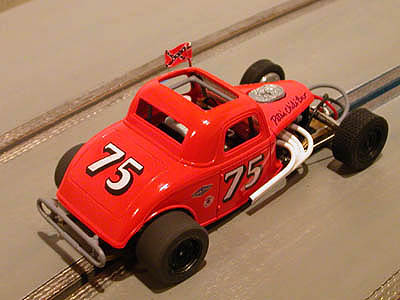
The car’s running gear is very similar to the purple car with brass chassis, floating front end, BWA wheels & inserts, Indy Grips, brass rod roll cage and bumpers, Sakatsu motor and guide, Slot-It gears, etc. Headers were made from fairly pliable solid styrene rod with the ends of the exhausts drilled out. I probably also should have included nerf bars on the cars, although I don’t think they always had them.
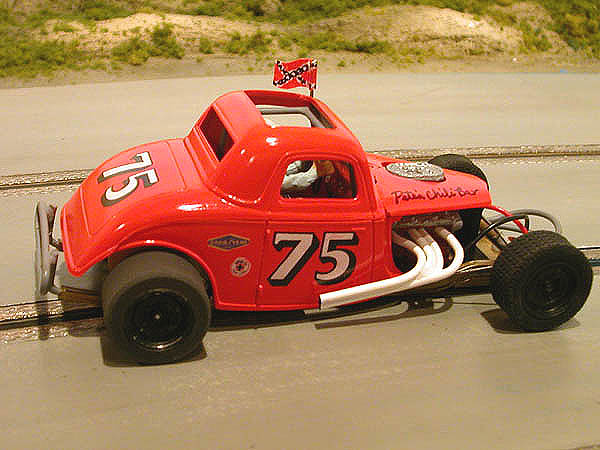
#00
The copper and cream-colored Palmer ’40 Ford sedan (I’m pretending it’s a ’39) is my interpretation of “Rocky” Rockvan’s double zero lunker. Rocky was a popular local competitor even though he usually ran near the back of the pack. The main challenge in building this car was fabricating the left side panel which was missing from the kit when I acquired it. After tracing the right side panel on sheet styrene I carved a mirror image and bent it over a hot light bulb to form the compound curve. It’s not perfect by any means, but hopefully close enough to be convincing.
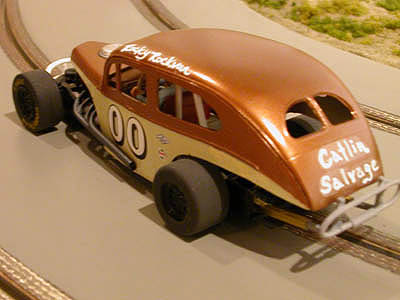
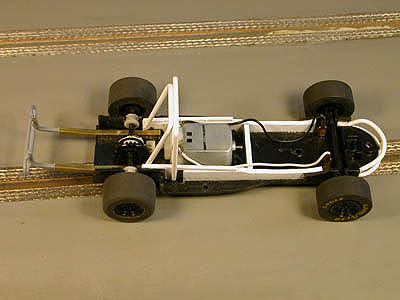
I took a different approach with the running gear of this car, and inspired by Bruce "DaVols" similar scratch building projects, decided to utilize the chassis from an old first generation Scaley NASCAR that had seen better days. Although the wheelbase and track were close enough, it required a lot of trimming to fit properly, as well as several styrene strips to reduce excessive flexing.
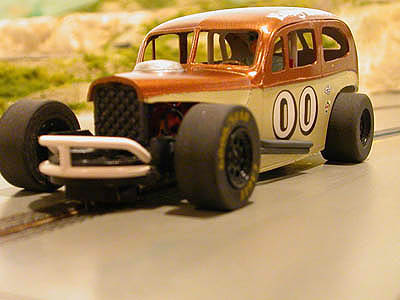
Roll bar, headers and bumpers are styrene, and with the plastic chassis the car is considerably lighter than the other cars which have a lot of brass components. It runs pretty well as-is, but I may eventually add a slab of brass or lead to the bottom of the chassis to make it handle better on my routed track. Numbers are from Patto, but sponsor is hand-painted.
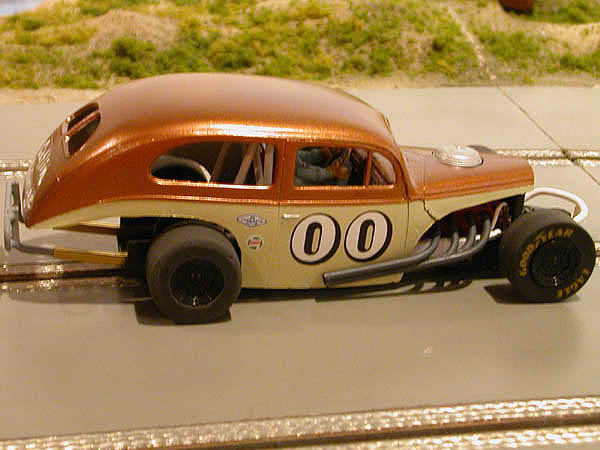
(I spent a lot of time poking around old wrecks at Catlin’s Salvage in my youth.) I still need to clear coat it (as can be seen from the damaged decal on the left rear panel), and add a wire screen to fend off the dirt clods.
It’s gratifying to see the interest in vintage stock cars and modifieds from several people on HRW, and I enjoy viewing their creations. Building static car models as a kid is where it all started for me, and although I love exotic European machines, I also still have a soft spot for American hot rods. It seems only natural now to build and race slot versions of the cars and drivers I idolized decades ago. My only regret is that there aren’t more suitable bodies of American classics available in 1/32. Purists may cringe at the lack of documentation, but its fun occasionally to build a car without worrying about every detail being absolutely historically correct. Don’t get me wrong -- I value scale accuracy as much as the next guy...but for these “home brew specials” as long as the cars match the images in my memory and convey the aura of the times, I’m satisfied. Frankly, I’m amazed I can still recall the cars, colors and numbers for these guys 40 years later.
Simple times -- young and impressionable for sure!
- "Speedyweenie"